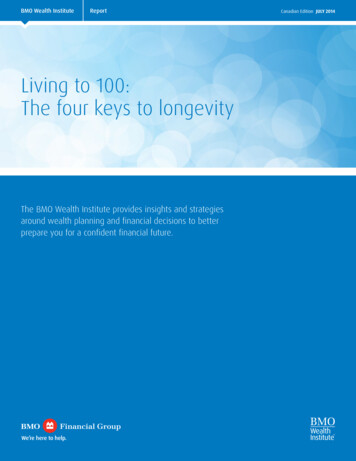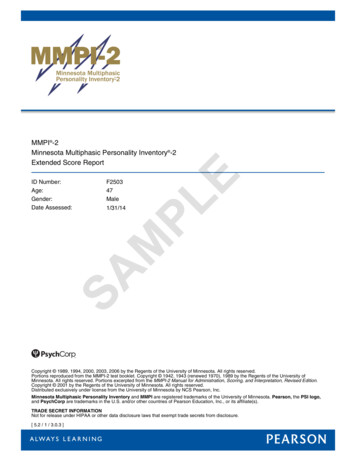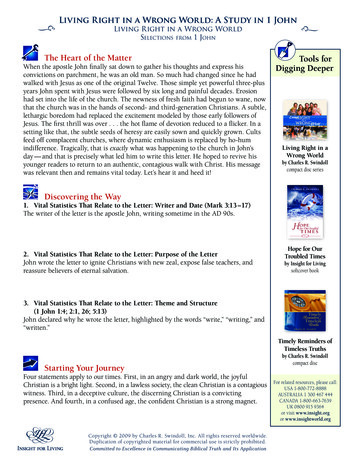
Transcription
BMO Wealth InstituteReportLiving to 100:The four keys to longevityThe BMO Wealth Institute provides insights and strategiesaround wealth planning and financial decisions to betterprepare you for a confident financial future.Canadian Edition JULY 2014
BMO Wealth InstituteLiving to 100: The Four Keys to LongevityCanadian Edition JULY 2014Famous comedian George Burns was once quoted as saying, If you live to be one hundred, you’vegot it made. Very few people die past that age. By 2061, it is estimated that there will be more than78 thousand centenarians living in Canada1. This is a huge increase from about six thousand reportedin the 2011 Census. For most people, planning for retirement or their later years is focused mostlyon finances and how they will spend their time. However, ensuring they spend those years in goodhealth is something that many overlook. The times are certainly changing, with medical advances andtechnological breakthroughs, planning for retirement and living longer needs to be more holistic.In 1970, average life expectancy at birth in Canada was 69 years for males and 762 for females.By 2011, it had increased to 79.3 years for males and 83.6 years for females. 3 Today, accordingto Statistics Canada, there are over 5.3 million people in Canada aged 65 or older, accountingfor about 15.3 percent of the total population4. Of the Canadian population that is over the ageof 14, the number of those 65 and older will almost double from 21% currently to 37% by theyear 2030. 5The vast majority of baby boomers—those born between 1946 and 1964—are on a quest toimprove their odds of living longer than previous generations. They not only want to live longer,they want to live healthily, happily and more financially secure than ever before. Althoughthere is no magic potion to ensure a long and healthy life, there are some notable accounts ofindividuals, families, and even whole communities that have defied the aging odds.The holy grail of longevityIn one such amazing story, Stamatis Moraitis, a Greek veteran of World War II, narrates how hewas diagnosed with lung cancer in the 1960s while living in the United States.6 He decided toforgo chemotherapy, and instead returned to his birthplace, Ikaria, the island where “peopleforget to die”. Moraitis abandoned his western diet and lifestyle and embraced the traditionalisland culture. His American doctors had told Moraitis he had only nine months to live, yetafter moving to Ikaria he was still living – cancer free – 45 years after his original diagnosis.According to the story, he never had chemotherapy, took drugs or sought therapy of any sort.All he did was move home to Ikaria and embrace the local lifestyle. He claimed he evenoutlived his U.S. physicians who, decades earlier, had predicted his imminent death as the onlyplausible outcome of his devastating diagnosis.Moraitis is not alone when it comes to longevity on the island of Ikaria. In fact, University ofAthens researchers have concluded that people on Ikaria are reaching the age of 90 at twoand-a-half times the rate of their American counterparts.7Stark differences in their lifestyle are apparent, even to a casual observer. Stress factors such asdaily schedules don’t exist on Ikaria. Although the average Ikarian regularly performs vigorousactivities, it’s never considered exercise. The island has a symbiotic attitude characterized byequal acceptance and accountability for everyone. Keeping up with the neighbors on the islandof Ikaria translates into good health, happiness and well-being for all.If you pay carefulattention to the wayIkarians have livedtheir lives, it appearsthat a dozen subtlypowerful, mutuallyenhancing andpervasive factorsare at work.Dan BuettnerAuthor of Blue Zones2
BMO Wealth InstituteLiving to 100: The Four Keys to LongevityCanadian Edition JULY 20143Many traditional cultures with a strong ethnic heritage like Ikaria embrace the simplicity oflife. The Ikarian diet is also a factor. It features fresh vegetables, fruits, herbs, spices and localhoney, which are all products of weekly harvests that every citizen contributes to and benefitsfrom, thereby maintaining a social structure that literally nurtures the entire community. Thelegacy of an Ikarian lifestyle may be the closest we have come to discovering the holy grailof longevity.Obviously, the fast-paced culture and appointment-driven lifestyles of most Canadians isn’tconducive to tending to abundant gardens or taking daily naps, both of which provide healthbenefits and are common practices in Ikaria. However, by recognizing what works in othercultures, it may be possible to find an acceptable middle ground to tip the scales in favor ofa long and healthy life—no matter where you live.Unlocking the door to longevityTo try to further understand the keys to longevity, a survey was conducted to record andanalyze the views of over 1,000 Canadians on various aspects of aging.8The wide-ranging survey questions were focused around four aspects of life that many expertsin the field of aging consider to be the keys to unlocking the mysterious door to longevity.Aging is an inescapableprocess – aging well isa conscious choice.MindBody Mobility Sensory Aging Memory Emotions I nformationProcessingFinancial Financial Planning R etirement IncomePlanning Risk ManagementKeys to LongevitySource: Alexis Abramson Ph.D.Alexis Abramson Ph.D.GerontologistSocial Role Shifts Lifestyle Changes Community
BMO Wealth InstituteLiving to 100: The Four Keys to LongevityCanadian Edition JULY 20144The four keys: body, mind, social and financialNormal aging involves an ongoing physiological transformation. As your body and mindevolve and adapt, it’s helpful to re-evaluate both your physical and your mental status, andto determine what changes in your diet, exercise regime and general lifestyle are required topromote ‘healthy’ longevity. In addition, by putting the necessary tools in place as soon as youcan to ensure that you have a strong retirement and financial plan and a solid social structure,you are more likely to seamlessly adjust to your senior years.Although it’s never too late to make positive changes, keeping clear goals in sight is easierwhen good habits are formed and incorporated over a lifetime, rather than adopted as anafterthought. It’s critical that you devise a strategy that will help you remain vigilant about allaspects of your health, well-being, personal life and financial assets. By consciously nurturingthese four components, you can unlock your potential to achieve a long and rewarding life.Key 1: The bodyThe master key that unlocks every other doorGood health is one of the basic elements required to achieve long life; without it, everythingelse is diminished. Now is the time to initiate the changes necessary to maximize your currentand future health status.Research conducted by Dr. Dean Ornish and his team at the University of California, SanFrancisco concluded that following a program of “healthy eating, exercise and stress reductioncan not only reverse some diseases—it may actually slow down the aging process at thegenetic level.”9In fact, longevity odds are greatly influenced by your personal lifestyle choices. Other aspectsof good health should include:Adequate sleep (7 to 8 hours per night, and naps as needed). Regular stretching and deep breathing to keep your joints flexible and your body oxygenated.Physical activity that includes both high- and low-impact exercise at least 3 times a week.Drink at least 8 glasses of water daily.Generous amounts of dark leafy vegetables, fresh fruits and whole grains in your daily diet.Eliminating or reducing the amount of unhealthy fats, processed sugars and preservatives inyour diet.Consuming a moderate amount of alcohol (e.g., just a glass of red wine with dinner).Most Canadians (88%)have taken some stepsto help them live alonger life.BMO Wealth Institute survey
BMO Wealth InstituteLiving to 100: The Four Keys to Longevity14%Canadian Edition JULY 201414 %24%62%24 %AverageBelow Average62 %Above AverageCurrent Level of HealthSource: BMO Wealth Institute survey by Pollara, March 2014The survey noted that there is always room for improvement as we strive to increase ourlifespan. The most common initiatives are eating healthily (55%), exercising (47%) and visitingtheir doctor regularly (43%).When asked how they would rate their level of health based on their age, the majority ofsurvey respondents considered themselves to be of average health for their age (62%), withapproximately one-quarter saying their current level of health was above average (24%).Approximately one in ten (14%) considered their health was below the average for their age.Younger Canadians, those in the 18–29 age category, were more likely to consider their currentlevel of health to be above average, as compared to older Canadians, aged 50-68.Key 2: The mindThe fundamental keyLiving your best life depends on a healthy brain. A recent article explores the best ways toimprove your brain power for life.10 This article reveals that functioning to our fullest capacity isdirectly linked to the health of our brains. The article suggests that you incorporate these fourfundamental lifestyle changes to boost your brain power. Cognitive training Memory, reasoning, and speed-of-processing exercises create a winningcombination for cognition.Aerobic exercise People who exercise moderately to vigorously just once a week are 30 percentmore likely to maintain their cognitive function than those who do not exercise at all. Don’t smoke Non-smokers are nearly twice as likely to stay sharp in old age as thosewho smoke.Maintain social networks People who work, volunteer and maintain close-knit human bondsare 24 percent more likely to preserve cognitive function in late life.Above AverageBelow AverageAverageLiving your bestlife depends on ahealthy brain.5
BMO Wealth InstituteLiving to 100: The Four Keys to LongevityCanadian Edition JULY 20146The survey results revealed that loss of mental ability was the biggest concern thatrespondents had about living to 100 and beyond.Below is a complete list of the feedback received when respondents were asked for theirbiggest concern about living to 100.It’s a common myth that an older brain is not as sharp as a young one. The good news isthat research tells us that comparisons between the human brain and computers suggestotherwise.11 We must take into consideration that an older mind has stored and processedmuch more information over the course of a lifetime than someone in, for instance, their 20s.Although the information is still accessible, at some point it begins to take longer to process,much like a well-used computer’s hard drive.The brain, just like the muscles of the body, requires regular exercise to keep the mind sharp.Mature adults are rising to the challenge by adapting to the technology wave and incorporatingactivities that challenge the thinking process, including surfing the web, online gaming, andusing an electronic reader to catch up on the latest book. There is no doubt that all of theseactivities sharpen your cognitive skills – the key to optimal mental health.Key 3: SocialThe key to enjoying lifeThe progressiveincrease of datamay cause the olderbrain to process allthe information a bitmore slowly, but weultimately continueto become moreintelligent with age.Christopher BerglandPsychology TodayThe popularity of personal bucket lists has ignited a passion in seniors to take up new hobbies,write their life stories, or develop new careers. Senior wanderlust knows no boundarieswhen it comes to fulfilling dreams after raising a family and retiring from a dedicated career.Survey results suggest there are a plethora of new activities respondents are interested inincorporating into their daily lives after retirement.56Losing mental abilities366Relying on others totake care of my health474010 2Losing people I love46411036Medical costsRelying on others totake care of me financiallyNot being able to enjoyactivities I used to doNot being able to affordthe lifestyle I am used to422437276164421317502715194032BoredomLiving with regrets3938304256% of Canadians werevery worried aboutlosing their mentalabilities later in life, andan additional 36% weresomewhat worried.251116Very worriedSomewhat worriedNot very worriedNot at all worriedPercentBiggest Concerns About Living to 100Source: BMO Wealth Institute survey by Pollara, March 2014Not at all worriedNot Very worriedSomewhat worriedVery worriedBMO Wealth Institute survey
BMO Wealth InstituteLiving to 100: The Four Keys to LongevityCanadian Edition JULY 2014Spending more time on hobbies and starting part-time jobs were both shown to be highlydesirable new activities on the list for many survey respondents and this is widely seen as apositive outcome. Researchers at the Institute of Economic Affairs in the U.K. recently identified arange of substantially negative effects on health after retirement. Their study found retirement tobe associated with a significant increase in clinical depression and a decline in self-assessed health.These effects were shown to grow as the number of years people spent in retirement increased.12The encouraging link between continuing to work and longevity is exemplified in the Chiantiregion of Italy, located in Tuscany between the cities of Florence and Siena. In this wine region,the family-owned vineyards are often passed on from generation to generation. While theelders may leave the more taxing jobs to the youngsters, they never fully retire. The oldermembers of the family continue to walk the rows of vines to make sure the grapes are ingood condition and participate in tastings to ensure the quality of the wine, and they remaininvolved in important business decisions. Many locals claim it’s their ongoing daily involvementthat is responsible for their exceptionally long and healthy lives.If you’re looking to boost your level of social interaction, to supplement your income, or areseeking a productive way to fill your time, you may want to consider taking on a part-time job.Spend more timeon your hobbies6625Start a new part-time job19Learn a new languageWrite your memoirs14Take a university/collegecourse13Start your own businessStart a website/blog109Start a new career5Other6None of the above14PercentNew Activities During Old AgeSource: BMO Wealth Institute survey by Pollara, March 2014Besides the financialadvantages, thereare other compellingreasons to considerreturning to theworkforce afterretirement.7
BMO Wealth InstituteLiving to 100: The Four Keys to LongevityCanadian Edition JULY 2014852To stay mentally sharp46To get out of the houseThose who regularlyinteract with theirfriends and peers areoften the happiestand the healthiest,especially whensocial connectionsare maintained andpreserved over thecourse of a lifetime.42To socializeEarn money to improvelifestyle4035Will need the money32To stay physically fit28To do something I loveTo learn new skills16PercentReasons for Working During RetirementSource: BMO Wealth Institute survey by Pollara, March 2014Alexis Abramson Ph.D.GerontologistThe survey results revealed additional motives respondents suggested would influence theirdesire to work part-time after retirement.We are all social creatures at heart. The simple act of a good conversation with a close friendor family member can provide acceptance, understanding, compassion and even an occasionalwake-up call when necessary.John Cacioppo, a University of Chicago social psychologist and neuroscientist who studies thebiological effects of social isolation, has found that a lack of social connectedness leads toloneliness and can be linked to dramatic increases in stress, hardening of the arteries andinflammation in the body. Cacioppo and his research team also found that social isolation candiminish the brain’s executive function, learning and memory. There is no doubt that we allrequire ongoing social connectivity to maintain optimal health and longevity.Spend time withfamilySpend time withgrandchildrenVolunteerGet involved withcommunity issuesVisit 1537951Spend time withfriends26752Keep in touch viaphone and email309589539541113148688More often87Less oftenSame amountDon’t KnowPercentExpectation of Activities During Old AgeSource: BMO Wealth Institute survey by Pollara, March 2014Not at all worriedNot Very worriedSomewhat worriedVery worriedA strong social networkand financial securityare shown to be themost importantfactors associatedwith enjoying an ideallifestyle in old age.
BMO Wealth InstituteLiving to 100: The Four Keys to LongevityCanadian Edition JULY 20149When contemplating expectations of increased involvement in current activities during oldage, survey respondents cited social connectivity with family as their primary desire. Intheir golden years, those surveyed expected they will spend more time with family (58%),grandchildren (52%) and friends (47%), as well as keeping in close touch via phone or email(51%). A number of them (34%) also indicated that they would participate in volunteeractivities in some capacity.When asked what the most important factor was when it comes to enjoying an ideal lifestylein old age more than one-quarter (27%) of respondents stated it was staying in contactwith family and having a strong social support network. While financial security came in aclose second, it was cited by 25% of the survey respondents as being the most importantcharacteristic associated with an ideal lifestyle in old age—just above “having fun and doingactivities I enjoy” (22%). Interestingly, financial security proved to be much more importantto Canadians ages 50-68 (31%) than for younger Canadians ages 18-29 (15%).Staying in contact with familyand a support network2725Being financially secureHaving fun and doingactivities I enjoy2218Staying fitEating healthy food7PercentMost Important Factors for Enjoying an Ideal Lifestyle in Old AgeSource: BMO Wealth Institute survey by Pollara, March 2014Key 4: FinancialThe key to successCanadians clearly understand that an important component of successful longevity is havinga sense of financial security. Although financial security was cited as a lower priority thanmaintaining a social network of family and friends for the majority of Canadians surveyed,financial security gains importance with age and as personal assets increase over a lifetime. Thesurvey results showed that those with the highest income levels expressed the greatest concernover their finances after retirement. The wealthiest plan to preserve their financial security aboveenjoying personal pursuits, socializing, exercising and maintaining a healthy lifestyle.Financial securitygains importancewith age and aspersonal assetsincrease over a lifetime.
BMO Wealth InstituteLiving to 100: The Four Keys to LongevityCanadian Edition JULY 2014Future health-care costsWhile those surveyed acknowledged the potential impact of future health-care costs, fewseemed to appreciate the extent of the health-care expenses that they will incur. Respondentsalso did not appear to fully understand that there are proactive measures that can be takento help minimize their potentially spiraling medical expenditures. Long-term care insurance isone such measure that may be part of the strategy to help curtail these expenses in the future.It may seem like peace of mind at a price, but not when you consider that the likelihood ofa retiree needing some type of long-term or in-home care increases with age. According toStatistics Canada, there is about a 10% chance of needing long-term care by age 55, about 30%chance by age 65, and about a 50% chance by age 7513. These costs can have a huge impacton a couple’s retirement. As an example, the cost to live in a private nursing home in B.C. canrange from about 11,650 to over 37,100 per year.14 The cost varies considerably from oneprovince to the next.ProvinceRetirement homes/residencesNursing homes Yearly Cost Yearly 00042,00012,40028,900New 000Nova 29,300Prince Edward 000The Private Cost of Long-Term Care in CanadaSource: Senioropolis Inc., 2014One way to help meet your future health-care expenses is to actively fund a Tax Free SavingsAccount (TFSA). These accounts provide the opportunity to deposit funds and grow them on atax-free basis. However, the annual contribution is currently limited to 5,500 for each person.Below is a list of the expenses survey participants felt would most impact their senior years.The state of health care and its associated costs are constantly evolving in Canada. Here aresome steps you can take to keep pace with insurance industry developments and the changesin provincial health coverage.10
BMO Wealth InstituteLiving to 100: The Four Keys to LongevityCanadian Edition JULY 20141174Medical and healthFood, clothing, and otherday-to-day essentials5756Housing38Long-term careTravel2819Entertainment and hobbies15Debt paymentsSupporting adult children/grandchildren13PercentLargest Expenses in Old AgeSource: BMO Wealth Institute survey by Pollara, March 2014Review your insurance coverage to make sure you have the best coverage and accessto health care available and that you aren’t paying for features that you don’t need.Discuss your insurance coverage options with trusted professionals and compare costs toensure you’re enrolled in the plan that best suits your specific medical needs.Overall, the majority of survey respondents anticipate the financial impact of health-careexpenses to be significant as they age, even with government provided health care. In fact,the Canadians surveyed expected to spend an average of 5,391 a year on out-of-pocketmedical costs after the age of 65.Surprisingly, even with provincial health care coverage – Canadians foresee medicaland health costs to be the single largest expense for old age (74%). Other significantexpenses include food, clothing and day-to-day essentials (57%) and housing (56%).20Under 1,00030 1,000 to 5,00016 5,000 to 10,000 10,000 to 15,0006 15,000 to 20,0003 20,000 or more321Don’t knowPercentEstimated Annual Medical Costs After Age 65Source: BMO Wealth Institute survey by Pollara, March 2014Canadians expectto spend an averageof 5,391 a year onout-of-pocket medicalcosts after the ageof 65.BMO Wealth Institute survey
BMO Wealth InstituteLiving to 100: The Four Keys to LongevityCanadian Edition JULY 2014Fail to plan — plan to failOne of the easiest ways to increase confidence in your financial security is to work with afinancial advisor to develop a retirement plan. Yet, those who have taken this important step arestill in the minority.The survey results reflect a relatively low level of planning among pre-retirees, and at thesame time demonstrate the comparative confidence that comes with a financial plan. Of thosesurveyed, only 19% actually have a financial plan. The survey also found that those who statedthey were confident that they will be financially secure in their retirement, 25% have a financialplan, and 22% have discussed their situation with a financial advisor. For those that are notconfident about a financially secure retirement, only 5% have a financial plan, and only 13%have consulted with a financial advisor. The survey appears to show that working with a financialadvisor may increase your confidence in your ability to meet your financial goals in retirement.30Made regular contributions to an RRSPTalked to a financial advisor19Created a financial plan1918Made contributions to another retirement fundMade occasional contributions to an RRSP15Maximized contributions to an RRSP1513Made regular contributions to a TFSA11Maximized contributions to a TFSA10Made occasional contributions to a TFSA2Other24None/NothingPercentSteps Taken to Prepare for RetirementSource: BMO Wealth Institute survey by Pollara, March 2014The majority of respondents have made contributions to a Registered Retirement Savings Plan(RRSP) or pension plan, often through employer-sponsored plans. But a large percentage of people(24%) have not yet put in place any steps to prepare for their retirement. The following tableshows steps that respondents to the survey have taken towards preparing for their retirement.The need for financial security becomes more apparent as we age. When regular employmentincome is no longer part of the equation, the wealth accumulated during your working yearsmay help to fill the gaps. Uncertainty about future health care costs and the Canada PensionPlan (CPP) has forced us to become more resourceful and to seek out other long-term solutions.Confidence comeswith a plan.bmo.com/confidence12
BMO Wealth InstituteLiving to 100: The Four Keys to LongevityAn important first step is to talk with a financial advisor who will work with you to develop afinancial plan that, among other things, looks at your retirement income needs and ways tomeet these financial goals that are in line with your tolerance for risk. By working togetherwith your BMO financial professional, you can discover new doorways to financial security thatmay help to sustain you in your golden years.A final thoughtThe compelling findings of the survey speak to the need for all of us to have a better overallplan when it comes to the four key components of longevity; body, mind, social and financial.Many challenges that may arise in our later years can be both anticipated, and properlyplanned for, by making smart decisions focused on the ultimate goal of successful longevity.Certainly, there are lessons to learn from the resiliency found in the people of Ikaria. With littleelse to sustain their culture, value is placed on the most simple, yet endearing aspects of livinga satisfying life – like interacting with neighbors and enjoying a good meal with friends andfamily. If attitude and fortitude were the most-valued assets, Ikarians might possibly be therichest people on the planet.Canadian Edition JULY 201413
BMO Wealth InstituteLiving to 100: The Four Keys to LongevityFootnotes Can lifestyle changes reverse coronary heart disease? Ornish D, Brown SE, Billings,JG, Scherwitz LW, Armstrong WT, Ports TA, McLanahan SM, Kirkeeide RL, Gould KL,Brand RJ. The Lancet, July 21, 1990. abstract (accessed June icle/PII0140-6736(90)91656-U/9 Life Expectancy at Birth, By Sex, By Province, Statistics Canada. 2012.(accessed June som/l01/cst01/health26-eng.htm102 Mortality: Overview, 2010 and 2011. Martel, L. Statistics Canada. September 2013.(accessed June /article/11867-eng.htm14s Centenarians in Canada: Age and sex, 2011 Census. Statistics Canada.May 2012. (accessed June /2011/as-sa/98-311-x/98-311x2011003 1-eng.cfm.1Canadian Edition JULY 2014 What Is the Best Way To Improve Your Brain Power For Life? Bergland, Christoper.Psychology Today. January 21, 2014. (accessed June rain-power-life3 Canada’s Population Estimates: Age and Sex, 2013. Statistics Canada. 2013.(accessed June 25/dq131125a-eng.htm Forget about forgetting: Elderly know more, use it better. Ramscar M. UniversitaetTubingen, January 20, 2014. (accessed June /140120090415.htm114 Economic and Fiscal Implications of Canada’s Aging Population.Department of Finance. October 2012. (accessed June t-rapport-eng.asp Work longer, live healthier. Sahlgren GH. Institute of Economic Affairs,May 2013. (accessed June blications/files/Work%20Longer,%20Live Healthier.pdf125 The Greek island of old age. Bomford, Andrew. BBC News,Last updated January 6, 2013. (accessed June 2014)http://www.bbc.com/news/magazine-208983796 Sociodemographic and lifestyle statistics of oldest old people ( 80 years) living inIkaria Island: The Ikaria Study. Panagiotakos DB, Chrysohoou C, Siasos G, ZisimosK, Skoumas J. Pitsavos C. Stefanadis C. Cardiology Research and Practice, February2011. (accessed June dopt Abstract7 Canadians Ill-Prepared For Long-Term Care Costs. Benefits Canada Website.June 22, 2012. (accessed June e-costs-2991713 Senioropolis Inc., 2014. There is no Canada wide standardization with respectto either retirement or nursing homes. Each province uses slightly differentterminology and may not include the same criteria in their pricing. These numbersare directional only and should not be used for planning or budgeting.14 Survey conducted by Pollara for the BMO Wealth Institute between February 27,2014 and March 3, 2014 with an online sample size of 1,007 Canadians. Overallprobability results for a sample of this size would be accurate to within 3.1%,19 times out of 20.04/15-6808BMO Financial Group provides this publication to clients for informational purposes only. The information herein reflects information available at the date hereof. It is based on sources that we believe to be reliable,but is not guaranteed by us, may be incomplete, or may change without notice. It is intended as advice of a general nature and is not to be construed as specific advice to any particular person nor with respect to anyspecific
Jan 06, 2013 · BMO Wealth Institute Living to 100: The Four Keys to Longevity Canadian Edition ULY 2014 2 In 1970, average life expectancy at birth in Canada was 69 years for males and 762 for females. By 2011, it had increased to 79.3 years for males and 83.6 years for females.3 Today, according to Statist










